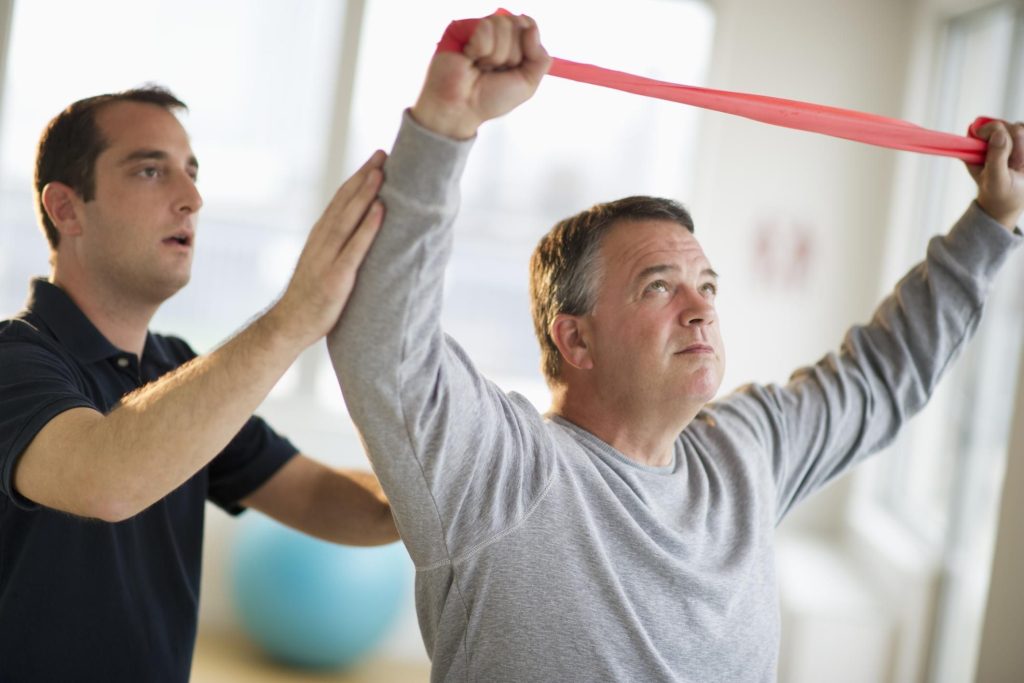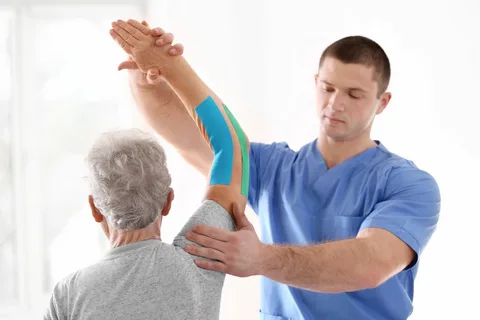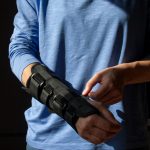Perhaps you or your loved one has encountered an elbow fracture. This injury is not only excruciatingly painful but can also significantly diminish your quality of life.
Insufficient or improper treatment and rehabilitation can lead to chronic problems: loss of mobility, arthritis, and even disability.
In this article, we will explore how to effectively navigate all stages of recovery after an elbow fracture. From the first aid and diagnosis to physiotherapy and psychological support, all of this will help you or your loved ones return to a full life.
In addition to everything else, it is strongly recommended to watch the Video Exercises for Elbow Fracture Rehabilitation for additional practical information.
What Is an Elbow Fracture?
An elbow fracture is a serious injury in which the integrity of the bone structures that make up the elbow joint is compromised. The elbow joint is formed by the interlocking of three bones: the humerus, radius, and ulna. This joint has high mobility and a complex anatomical structure, making it vulnerable to injury.
Causes of Elbow Fractures
Elbow fractures often occur as a result of falls on an outstretched arm, accidents, sports injuries, or direct blows to the elbow joint.
Physiological Consequences
In the case of an elbow fracture, there is not only mechanical damage to the bones, but often there are also concurrent injuries to soft tissues: ligaments, tendons, muscles, and nerves. This can lead to temporary or even permanent loss of joint function, pain, swelling, and hematomas.
Why Is Rehabilitation Important? The Importance of Proper Treatment
The correct approach to treatment and rehabilitation is critically important for restoring joint function and preventing long-term complications such as arthritis or contractures (limited mobility).
Key Stages of Treatment
In this section, we will examine key points, starting from the initial visit to the doctor and ending with the final stage of recovery after cast removal. Special attention should be paid to rehabilitation after an elbow olecranon fracture, as this process plays a crucial role in a fast and effective return to normal life.

First Aid
- Immediate Actions: First aid for an elbow fracture involves immobilizing the injured arm using a splint or bandage. This should be done as quickly as possible to reduce the risk of further injury.
- Timeframe: Within the first 24-48 hours, it is essential to apply a cold compress to reduce swelling and pain.
Diagnosis
Procedures and Timelines: After the initial assessment, the doctor will prescribe an X-ray or MRI for accurate diagnosis. This usually occurs within the first few hours to two days after the injury.
Surgical and Conservative Treatment

After diagnosing an elbow fracture, the doctor decides on the treatment method: surgical or conservative.
Conservative Treatment
Conservative treatment includes:
- Immobilization of the joint (applying a cast or splint).
- Use of anti-inflammatory and pain-relieving medications.
- Continuous monitoring and follow-up X-rays.
This method is preferred for uncomplicated fractures that can heal on their own without surgical intervention.
Surgical Treatment: Osteosynthesis
Typically, complex and multiple fractures require surgical intervention. Osteosynthesis is the process of connecting bone fragments with metal pins (rods), plates, and screws.
Surgical Treatment: Metal Osteosynthesis
Metal osteosynthesis is a type of osteosynthesis where metal implants are used to fix bone fragments. This method is more reliable but comes with its risks, such as metal allergies or potential implant displacement.
Selecting the Treatment Method
The selection of treatment method depends on many factors: the type of fracture, the patient’s age, overall health, etc. A careful approach to selecting the method will help avoid long-term complications and accelerate the recovery process.
Depending on the treatment method and individual body characteristics, the duration of rehabilitation may vary. Typically, a full recovery course can take from several weeks to several months.
Video: “Rehabilitation for the upper limb disorders”
Upper limb. Set No.1 improvement of mobility and range of joint movement
UPPER LIMB: SET №5 EXERCISES FOR ELBOW JOINT
For additional information about the rehabilitation of the upper limb disorders, you can watch a video demonstrating exercises and rehabilitation recommendations.
Treatment Methods
In this section of the article, we will provide an overview of various treatment methods that can be used to accelerate the recovery process, including those that can be performed at home. This is especially relevant for patients in the rehabilitation phase after an elbow fracture, where each selected method can significantly impact the rate and quality of recovery.
Physiotherapy
Physiotherapy is a key component of the rehabilitation process after an elbow fracture. It includes various methods that contribute to faster recovery and improved quality of life.
Types of Therapy and Their Benefits:
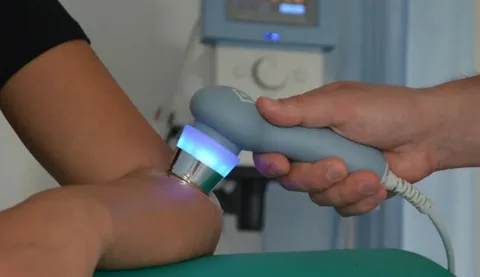
- Electrotherapy: Using electrical impulses to stimulate muscles and improve blood circulation. Timeline: Typically begins 2-3 weeks after the injury, duration varies based on the patient’s condition.
- Ultrasound Therapy: Helps improve microcirculation and reduce inflammation. Timeline: Can start around 3-4 weeks and last for several months.
- Mud Therapy: Used to reduce inflammation and improve tissue condition. Timeline: Usually begins 1-2 months after the injury, lasting for several weeks.
- Heat Therapy: Application of heat to relax muscles and reduce pain. Timeline: Can start immediately after active inflammation subsides, as per the doctor’s recommendation.
- Cryotherapy: Using cold to reduce inflammation and pain. Timeline: In the early stages of recovery, typically in the first 1-2 weeks.
- Hydrotherapy: Water-based procedures for muscle relaxation and blood circulation stimulation. Timeline: After the fracture stabilizes, duration as per the doctor’s recommendation.
Impact on Recovery:
All these methods together can significantly accelerate the recovery process, helping reduce pain, improve mobility, and enhance the overall functionality of the elbow joint. They can also reduce the risk of complications and shorten the time period needed to return to daily life.
Note: All timelines and methods of physiotherapy should be individualized and applied only under the guidance of a doctor.
Exercises for Recovery After an Elbow Fracture
An elbow fracture is a serious traumatic injury that requires a comprehensive treatment approach and a lengthy long recovery period. One of the key elements of successful recovery after an elbow fracture is performing exercises designed specifically for this purpose. These exercises not only help improve joint mobility and flexibility but also strengthen the muscles that support the elbow joint and forearm. In this section, we will present you with a set of exercises that can be done at home or under the supervision of a specialist to expedite accelerate your recovery process after an elbow fracture.
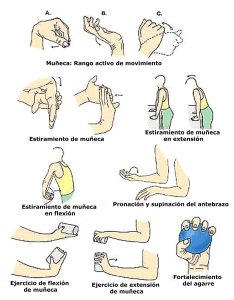
- Wrist Flexion and Extension: Sit at a table, lower your arm downwards, and slowly flex and extend your wrist.
- Lifting Objects: Use small dumbbells or a water bottle to lift and lower your arm.
- Elbow Rotations: Rotate your arm inward and outward, exercising caution.
- Ball Squeezing: Squeeze and release a soft ball in your hand.
- Hula Hoop: Use a resistance hoop for gentle pulling in different directions.
- Finger Extension: Stretch your fingers wide, then slowly make a fist.
- Shoulder Shrugs: Raise and lower your shoulders.
- Elbow Push-offs: Push off gently from a wall or another support to feel a light effort in the elbow joint.
Note: It is recommended to perform all exercises under the supervision of a specialist.
How to Avoid Overexertion
Overexertion after an elbow fracture can lead to several undesirable consequences, including worsening inflammation, recurrent injuries, and even chronic joint issues. Therefore, it’s important to know how to avoid this.
Dangers of Overexertion
- Delayed Recovery: Overexertion can prolong the time period needed for full recovery.
- Increased Risk of Re-fracture: Excessively intense exercises can lead to additional injuries.
- Chronic Pain Syndrome: Persistent overexertion can turn pain into a chronic condition, requiring additional treatment.
Ways to Avoid Overexertion
- Follow Medical Recommendations: Always consult with your doctor or physiotherapist about which exercises are suitable for you.
- Gradual Progression: Start with gentle exercises and gradually increase their intensity.
- Rest and Regeneration: Give your joint time to rest and recover between physiotherapy sessions.
- Proper Nutrition Adequate Diet and Hydration: These factors can expedite accelerate the recovery process and reduce the risk of overexertion.
- Listen to Your Body: If you feel pain or discomfort, it may be a sign of overexertion.
Timing
The gradual approach to physical exercises typically starts with 15-20 minute sessions, expanding to 30-45 minutes as your condition improves. Rest between sessions should be at least 24-48 hours to prevent overexertion.
Physical Therapy (PT) After an Elbow Fracture

Physical therapy (PT) is a crucial component of rehabilitation after an elbow fracture. This approach focuses on systematic use of physical exercises to restore joint function, improve general health, and prevent potential complications.
Goal of PT
The goal of PT is not only physical but also psychological recovery. It aims to improve the quality of life, restore normal functionality, and minimize the risk of recurring injuries.
Approaches in PT
- Joint Mobilization: The goal of these exercises is to maximize the range of motion and enhance joint mobility.
- Muscle Strengthening: Focuses on strengthening the muscles surrounding the joint to stabilize it.
- Coordination: Improving neuromuscular coordination to enhance movement efficiency.
PT Regimen
- Initial Phase (1-2 weeks): Involves gentle passive and active exercises to maintain range of motion.
- Intermediate Phase (3-6 weeks): Introduces exercises for muscle strengthening and improved mobility.
- Advanced Phase (from 7 weeks): Focuses on functional exercises that mimic everyday activities and work.
PT Recommendations
- Individualized Plan: Always develop an individualized PT plan in collaboration with qualified medical professionals.
- Frequency and Duration: 3-4 sessions per week, lasting 30-60 minutes each are typically recommended.
- Listen to Your Body: If you experience pain or discomfort, stop exercises immediately and consult your doctor.
Note: This section does not replace professional medical consultation. Consult healthcare specialists for a personalized rehabilitation plan.
Massage as a Treatment for Elbow Fracture
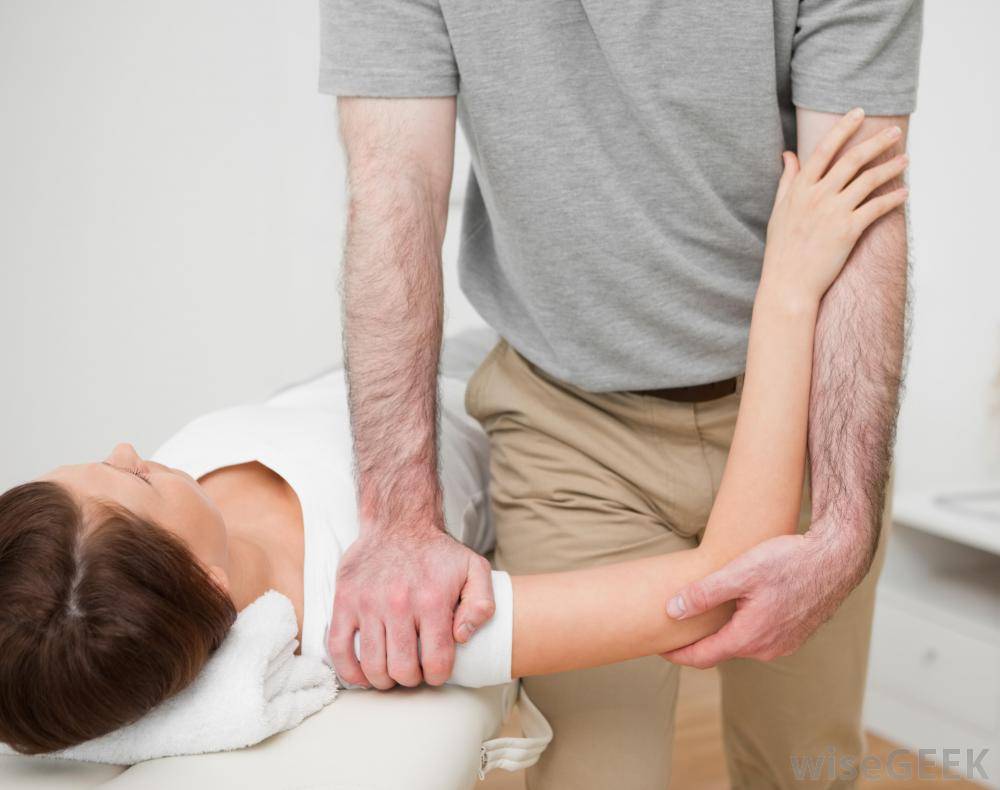
Massage is one of the effective methods in the rehabilitation process after an elbow fracture. It helps improve blood circulation, reduce muscle tension, and accelerate tissue healing.
Benefits of Massage in Rehabilitation
- Enhanced Blood Circulation: Massage stimulates blood flow to damaged tissues, which aids helps in their rapid recovery.
- Muscle Relaxation: Massage helps relax tense muscles around the elbow joint, particularly important after a period of immobility.
- Pain Reduction: Improved blood circulation and muscle relaxation often lead to reduced pain.
Types of Massage
- Lymphatic Drainage Massage: Used to reduce swelling and improve lymphatic flow.
- Myofascial Massage: Beneficial for relieving tension in muscle fascia.
- Sports Massage: Especially useful when a patient is preparing to return to an active lifestyle and sports.
Protocol and Timing
- Initial Phase (2-3 weeks post-injury): Massage is not recommended due to the risk of exacerbating the injury. However, gentle lymphatic drainage methods can be applied with a doctor’s approval.
- Intermediate Phase (4-8 weeks): More active forms of massage can be initiated to stimulate blood circulation and muscle relaxation.
- Advanced Phase (9 weeks and beyond): Focus on sports and myofascial massage to prepare for a return to an active life.
Recommendations
- Individualized Approach: Each patient is unique, so the massage program should be developed individually and coordinated with the treating physician.
- Frequency and Duration: Typically recommended at a rate of 1-2 sessions per week, lasting 20-30 minutes each.
- Professional Masseur: It is essential to consult a qualified specialist experienced in treating patients after fractures.
Reflexology

Reflexology is a method of treatment and rehabilitation that involves stimulating specific points or zones on the body to improve general health and specific functions. When applied used correctly, this therapy can be an excellent complement to the primary treatment of an elbow fracture.
Benefits of Reflexology in Rehabilitation
- Pain Relief: Stimulating specific points can reduce pain, especially during the early stages of rehabilitation.
- Improved Microcirculation: The effectiveness of treatment and the rate of recovery depend on the quality of blood circulation in the injured area.
- Relaxation and Stress Reduction: Reflexology helps alleviate psychological stress, which positively impacts the overall rehabilitation process.
Types of Reflexology
- Acupuncture: Using fine needles to stimulate points on the body.
- Acupressure: Mechanical pressure on reflex points.
- Electroreflexotherapy: The use of electrical impulses for stimulation.
Please note that all these therapies should be performed by qualified practitioners and in consultation with a healthcare professional.
Protocol and Timing
- Initial Phase (2-4 weeks): It is recommended to start with gentler methods, such as acupressure, to avoid further injury.
- Intermediate Phase (5-8 weeks): Acupuncture or electroreflexotherapy can be initiated, but only after consultation with a doctor.
- Advanced Phase (9 weeks and beyond): At this stage, you can intensify the procedures and increase their frequency.
Recommendations
- Qualified Specialist: This method requires a high degree of professionalism, so it’s essential to consult only qualified specialists.
- Individualization: The selection of stimulation points and the method of performing the procedure should be individualized.
- Combination of Methods: Reflexology is often most effective when used in combination with other rehabilitation methods to achieve the best results.
Mechanotherapy

Mechanotherapy is a method of physical therapy that uses mechanical forces to impact the body for improving the functional state of muscles and joints. In the context of rehabilitation after an elbow fracture, this method can be particularly beneficial.
Benefits of Mechanotherapy in Rehabilitation
- Restoration of Mobility: One of the primary benefits of mechanotherapy is improving the range of motion in the joint.
- Enhanced Microcirculation: Similar to reflexology, mechanotherapy also promotes better blood circulation, activating the healing processes.
- Pain Reduction: Effective targeting of muscles and joints can help reduce pain symptoms.
Types of Mechanotherapy
- Traction Therapy: Using devices to stretch joints and improve their mobility.
- Vibration Therapy: Applying vibrations to stimulate muscles and reduce pain.
- Hydrotherapy: Using water of varying temperatures and pressure for muscle massage and relaxation.
Protocol and Timing
- Initial Phase (1-3 weeks): During this period, it is best to use gentle methods, such as hydrotherapy, to avoid additional damage.
- Intermediate Phase (4-8 weeks): Traction and vibration therapy can be introduced but only after consultation with a doctor.
- Advanced Phase (9 weeks and beyond): If there are no contraindications, you can increase the intensity and frequency of sessions.
Recommendations
- Consultation with a Physician: Before starting any mechanotherapy course, it is necessary to consult with a doctor.
- Individualization: Like other methods, the approach should be individualized to suit the patient’s needs.
- Combined Therapy: Mechanotherapy is most effective when used in combination with other methods, such as physiotherapy and massage.
Nutrition and Supplements

Adequate diet is a key component of successful rehabilitation after an elbow fracture. It not only accelerates the healing process of bones and tissues but also helps manage adverse effects of treatment, such as fatigue or decreased immunity.
Proteins and Calcium
Proteins are essential for tissue regeneration and accelerating the healing process. Calcium plays a crucial role in bone formation.
Protein Sources:
- Chicken and turkey
- Fish (salmon, tuna)
- Eggs
- Dairy products (cheese, yogurt)
- Nuts and seeds (walnuts, chia, flaxseeds)
- Green leafy vegetables (spinach, cabbage)
Vitamins and Minerals
Vitamins D and C, as well as minerals like magnesium and zinc, are necessary to support immunity and general well-being.
Sources of Vitamins and Minerals:
- Fruits and vegetables (oranges, tangerines, broccoli)
- Seafood (shrimp, mussels)
- Nuts (walnuts, almonds)
Hydration
A sufficient amount of fluids is crucial for general well-being and improving circulation, which in turn accelerates the healing process.
Hydration Sources:
- Water
- Natural juices
- Green tea
Recommendations for Consumption:
- Diversity: Try not to limit yourself to one or two products from each category but vary your diet.
- Portions: Portion size is also important. Avoid overeating, as it can lead to excess weight, complicating rehabilitation.
- Consultation with a Doctor: Before making any significant changes to your diet, especially if you are already taking any supplements or medications, be sure to consult with a doctor.
Psychological Support

An elbow fracture and subsequent rehabilitation are not only physical but also psychological challenges. Therefore, psychological support is an important element of successful recovery.
Coping with Pain
Fractures and rehabilitation often come with pain, which can be a source of stress and anxiety. Here are some methods that can help:
- Meditation and breathing exercises: These can help reduce stress levels and focus on the healing process.
- Cognitive-behavioral therapy: This therapy can be useful for managing pain and attitudes toward it.
Motivation and Mental Attitude
Mood and motivation play a significant role in the recovery process.
- Goal setting: Set short-term and long-term goals for yourself.
- Visualization: Imagine yourself returning to a full life and achieving your goals.
Social Support
Support from friends and family is invaluable.
- Communication: Regularly share your feelings and progress with your loved ones.
- Professional Help: Sometimes, the assistance of a therapist or psychologist is necessary.
Recommendations for Application:
- Personal Responsibility: You are the main participant in the recovery process. Don’t hesitate to ask for help, but remember that the key to success is in your hands.
- Interaction with Healthcare Specialists: Regularly consult and monitor your emotional condition. This will help adapt the rehabilitation plan to your unique situation.
- Compliance with the Regimen: Rehabilitation is a marathon, not a sprint. Don’t try to accelerate the process at the expense of recovery quality.
Assessing Progress
For successful recovery after an elbow fracture, it is crucial to regularly assess rehabilitation progress. Understanding which stage you are at will allow you to make informed decisions about treatment methods.
Assessment Methods
- X-rays: These allow you to see the degree of bone fusion and the internal condition of the joint.
- Orthopedic evaluation/examination: This includes tests for mobility, strength, and pain levels.
- Functional tests: These help understand how well the joint copes with daily tasks and movements.
How to Know Rehabilitation Is Successful
- Pain Reduction: If pain diminishes and does not return even with the increased physical activity.
- Restoration of Functionality: You can perform basic movements without significant limitations.
- Improved Quality of Life: You feel capable of returning to daily tasks and work.
Possible Complications

It is essential to approach the recovery process after an elbow fracture with caution as various complications can occur. Being informed about them will help you make the correct decisions and seek medical attention if necessary.
Osteosynthesis
Osteosynthesis is a surgical procedure aimed at restoring the anatomical integrity of bones. However, like any surgical intervention, osteosynthesis can lead to several complications:
- Infections: The risk of developing postoperative abscesses or phlegmons.
- Fusion difficulties: Absence or incomplete fusion of the fracture.
- Osteomyelitis: Inflammation of the bone or bone marrow.
- Thrombosis: The possibility of blood clot formation in surrounding blood vessels.
Metal Osteosynthesis
Metal osteosynthesis is a type of osteosynthesis where metal rods, plates, or screws are used to fix bone fragments. It also has its risks:
- Allergic reaction to metal: Rare but possible.
- Implant displacement: Over time, metallic elements can shift, requiring further surgical intervention.
- Metal intoxication: In extremely rare cases, the release of metals into the bloodstream is possible.
Due to that, regular medical monitoring and control examinations are recommended after the operation.
If you have reason to believe that any complication is developing, it is essential to seek medical attention as soon as possible. Careful adherence to all medical recommendations and regular diagnostics will reduce the risk of these problems occurring.
Returning to Everyday Life and Work

Returning to normal life after an elbow fracture is a process that requires patience, consistency, and the right correct approach. Below are key aspects to help you prepare for what lies ahead.
Planning and Preparation
Before returning to work or regular activities, it is essential to undergo a medical examination and obtain clearance from a doctor. It is also important to anticipate the possibility of light physical activity and ensure the availability of means to support comfort, such as orthopedic aids.
Phases of Return
- Adaptation Phase (2-4 weeks): Start with light exercises and regular medical check-ups. Avoid heavy physical exertion and stress.
- Transitional Phase (1-2 months): Increase the intensity of exercises, but continue monitoring your condition. You can start performing simple work tasks.
- Full Recovery Phase (2-6 months): Gradually return to full workloads and your usual lifestyle. Continue regular medical check-ups.
Key Takeaways
- Physical Activity: Following medical recommendations, start with light exercises and gradually progress to more complex ones.
- Psychological Support: It is essential not only adhering to the regimen but also for maintaining motivation.
- Monitoring: Regular visits to the doctor for condition control and treatment plan
- Workplace Adaptation: Adapting the workplace may be necessary to comply with medical recommendations.
Professional Rehabilitation
If your profession involves physical exertion or requires special skills, it is recommended to undergo a course of professional rehabilitation. This may include specialized exercises, training in new work methods, or even retraining.
Ongoing Observation
Even after full recovery, regular medical check-ups are necessary to rule out possible complications and maintain joint health.
Conclusion
An elbow fracture is a serious traumatic event that requires a comprehensive and long-term approach to treatment and rehabilitation. It is important to remember that successful recovery is not only about physical but also psychological well-being. Following all recommendations and stages, starting from medical intervention and ending with a return to everyday life, contributes to a faster and more effective recovery.
To make this process as smooth as possible, close cooperation with your treating physician and other specialists is recommended. Continuous monitoring and treatment plan modifications, regular exercises, and adequate diet, all together create favorable conditions for your swift recovery.
In addition to the medical aspect, do not underestimate the importance of psychological support. Friends, family, and even professional psychologists can significantly help during the rehabilitation period.
In conclusion, taking care of your health starts with you, and nobody can do it better than yourself. Believe in yourself, follow the recommendations of specialists, and seize every opportunity to improve your health.

Check out the demo version of our sets of exercises for the Upper Limb Problems on YouTube
Our website presents the following sets of exercises for the upper limbs:
UPPER LIMB: SET №1 IMPROVEMENT OF MOBILITY AND RANGE OF JOINT MOVEMENT
UPPER LIMB: SET №2 STRENGTHENING THE MUSCLES OF THE SHOULDER COMPLEX AND JOINT STABILIZING. INITIAL STAGE
UPPER LIMB: SET №3 STRENGTHENING THE MUSCLES OF THE SHOULDER COMPLEX AND JOINT STABILIZING. MID STAGE
UPPER LIMB: SET №4 STRENGTHENING THE MUSCLES OF THE SHOULDER COMPLEX AND JOINT STABILIZING. ADVANCED STAGE
UPPER LIMB: SET №5 EXERCISES FOR ELBOW JOINT
UPPER LIMB: SET №6 EXERCISES FOR A WRIST JOINT AND HAND
Questions and Answers
-
What exercises are useful for preventing fractures?
Answer: Balance exercises, muscle and bone strengthening exercises such as walking, running, swimming, and yoga can be beneficial.
-
Are there any apps or technologies that can help in rehabilitation?
Answer: Yes, there are various medical apps and devices that can track your progress and offer rehabilitation exercises.
-
What is the placebo effect, and how can it affect rehabilitation?
Answer: The placebo effect is the improvement in a patient’s condition caused by belief in the effectiveness of treatment, even if the treatment is inactive. This effect can play a role in rehabilitation.
-
What alternative treatment methods can be used in addition to traditional medicine?
Answer: Acupuncture, homeopathy, and various types of massage can be used as complementary therapies, but their effectiveness should be discussed with a doctor.
-
Which professions are more susceptible to elbow fractures than others?
Answer: Professions that involve physical labor, increased activity, or working at heights (such as construction workers, athletes, acrobats) are at a higher risk of fractures.

